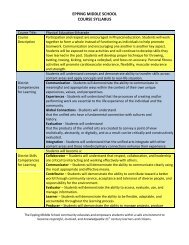Reading Standards for Informational Text & Literature - SAU 14
Reading Standards for Informational Text & Literature - SAU 14
Reading Standards for Informational Text & Literature - SAU 14
Create successful ePaper yourself
Turn your PDF publications into a flip-book with our unique Google optimized e-Paper software.
Range of<br />
<strong>Reading</strong> and<br />
Level of <strong>Text</strong><br />
Complexity<br />
Read and understand<br />
literature including<br />
stories, dramas, and<br />
poems proficiently at<br />
grade level<br />
Read and understand<br />
literature including<br />
stories, dramas, and<br />
poems proficiently at<br />
grade level<br />
Read and understand<br />
literature including<br />
stories, dramas, and<br />
poems proficiently at<br />
grade level<br />
High School<br />
Grades 9 and 10 Grades 11 and 12<br />
Key Ideas and<br />
details<br />
Craft and<br />
structure<br />
Integration of<br />
Knowledge<br />
and Ideas<br />
Show evidence about what the text<br />
means and interpret inferences in the<br />
text<br />
Understand how theme emerges<br />
Analyze how characters develop and<br />
interact<br />
Define words from context including<br />
figurative language, and point out<br />
references to the text<br />
Understand how structure manipulates<br />
a story’s timeline<br />
Read literature from outside the USA<br />
Compare the same subject or key scene<br />
in different mediums<br />
Analyze how an author trans<strong>for</strong>ms<br />
material into new <strong>for</strong>ms<br />
Recognize when matters are left<br />
uncertain<br />
Determine two or more themes and<br />
analyze how they interact to produce a<br />
complex account.<br />
Analyze author’s choices <strong>for</strong> developing<br />
elements of a story or drama<br />
Analyze the impact of specific word<br />
choice on meaning and tone, including<br />
words with multiple meanings or<br />
language that is fresh, engaging, or<br />
beautiful (include Shakespeare)<br />
Analyze how an author’s choices <strong>for</strong><br />
structure contribute to the overall<br />
meaning.<br />
Distinguish between what is directly<br />
stated and what is really meant (satire,<br />
sarcasm, irony, and understatement)<br />
Analyze multiple interpretations or a<br />
story, drama, or poem, evaluating how<br />
each interprets the source text (include<br />
Shakespeare and an American<br />
dramatist)<br />
Analyze how two or more texts from<br />
the 18 th , 19 th , and early 20 th Century<br />
foundational American <strong>Literature</strong> treat<br />
<strong>Reading</strong> <strong>Standards</strong> – In<strong>for</strong>mational <strong>Text</strong> and <strong>Literature</strong> Epping School District Page 15 of 16
















